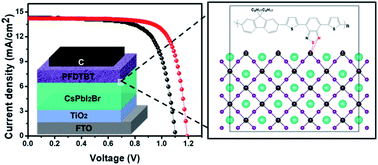Efficient carbon-based CsPbI2Br perovskite solar cells using bifunctional polymer modification†
Abstract
The inorganic CsPbI2Br perovskite with excellent thermal stability has become one of the potential candidates for commercial perovskite solar cells (PSC) in the future. However, the low efficiency and high humidity instability of CsPbI2Br PSC hindered its further development. To improve the device's performance, we use a bifunctional organic polymer material (PFDTBT) in the carbon-based CsPbI2Br PSC as an interface modification layer to achieve the function of improving the efficiency of the PSC. The application of PFDTBT reduces the energy level difference between the anode and CsPbI2Br and blocks the electron transfer from the perovskite layer to the carbon electrode. It also passivates the surface defects of the CsPbI2Br layer and improves the charge separation and extraction at the CsPbI2Br/anode interface. Meanwhile, the incorporation of the PFDTBT layer avoids the device's instability caused by the oxidation process and complex doping. After modification with PFDTBT, we achieve a high efficiency of 12.98%, which is the highest efficiency of devices with an undoped organic interface modification layer. Besides, the unencapsulated CsPbI2Br PSC with a dopant-free interface modification layer exhibited improved long-term stability in dry air for 25 days (relative humidity of 25%). This research provides a simple method for improving the performance of PSCs.



 Please wait while we load your content...
Please wait while we load your content...